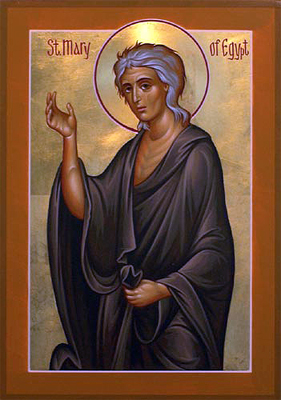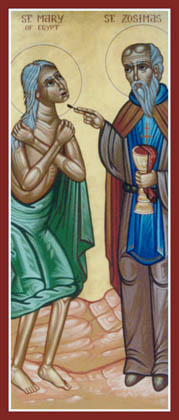|
|||
|---|---|---|---|
| This weekly bulletin insert complements the curriculum published by the Department of Christian Education of the Orthodox Church in America. This and many other Christian Education resources are available at http://dce.oca.org. | |||

Saint Mary of Egypt immediately recognized the holiness of a man she'd never seen before--the monk Zossimas--when he encountered her in the desert. She had come a long, long way to achieve that recognition of holiness in a man. Mary ran away from her miserable home at age twelve, and took to the streets. She had been abused, neglected, and deprived of the love that would have helped her see her own worth. Mary was strongly but darkly attracted to men. Unable to see the worth in others any more than in herself, she took perverse delight in enticing and then mocking men. For seventeen years she sold her body to any man who interested her. As Dr. Kyriaki FitzGerald has written, Mary convinced herself that she was free and living on her own terms. Yet she felt contempt and disgust for men, even as she avidly sought their embraces. Curiosity, and the promise of new customers, impelled Mary to join the crowd boarding a ship for Jerusalem. Once there she continued to follow the crowd to the cathedral. It was the Feast of the Exaltation of the Cross. Mary tried to enter the church, but at the threshold found herself thrust back as if by powerful arms. Shocked and distressed, she suddenly confronted the emptiness of her life. But almost at the same moment, she felt the loving gaze of the Theotokos in the icon. She begged the Mother of God to help her, to show her what her life should be. Approaching the threshold again, she felt herself drawn in rather than pushed out. Like other pilgrims, but now with her whole heart rather than idle curiosity, she worshipped at the foot of the cross. And in the midst of the throng, the Theotokos spoke words directed only to her: "Cross the Jordan, and you will find peace." By sunset of that day, Mary had reached the Church of St. John by the Jordan, where she was baptized and received Holy Communion. The next day she crossed the Jordan, and then began her forty-seven solitary years of struggle and intense prayer.
When the monk Zossimas came upon her in the desert, Mary knew who he was at once. A beautiful scene of mutual humility and respect followed. Zossimas prostrated himself and asked for her blessing; she in turn bowed down to him and asked for his. This went on until Mary said that he, as a priest, should bless her. He answered that it is not by one's rank but by the gifts of the Holy Spirit that grace is recognized. As recipient of those gifts, the monk said, Mary should bless him. So she finally did so. This woman who had once seen men only as objects of her lust was now able to recognize the holiness of a man she was seeing for the first time. By God's grace, Saint Mary of Egypt had, in the words of Hebrews 9: 14b, purified her conscience "from dead works to worship the living God." |
|||

